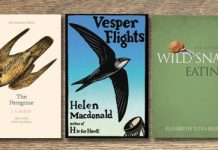Seaton based Magie Luff tries to avoid being classified or pigeonholed. She experiments with different mediums and styles. Katherine Locke has been to meet the part-time artist who was one of the winners of last year’s Marshwood Arts Awards.
‘Come on in’ says Magie Luff, opening the door to her Seaton flat. Situated in a period terrace overlooking the sea, it is the place she has called home for almost twenty years. When visiting artists in their homes or studios, there is always an element of surprise. Something new to stumble across or an unknown aspect of the artist’s work, but none more so than Magie Luff. Magie is making a name for herself as a printmaker and painter, winning several prestigious awards (including the Marshwood Arts Awards in 2015) and building an impressive body of work. She describes herself as ‘still experimenting’, but far from being a young artist fresh out of art school, Magie didn’t start working until 1996, when her adult children had left home.
Her entire working life has been spent as a hairdresser. ‘I started to cut hair when I was thirteen’, she tells me. She left school at fifteen and started work full time at a local hairdresser. Her hairdressing career has included running three salons of her own and she continues to work freelance in Seaton. ‘I took on clients when I moved here’, she says ‘There are a few who are now in their nineties and one who is over 100 years old! It is almost like a community service’.
Alongside working full time, Magie completed an HNC in Printmaking at SCAT (Somerset College of Arts and Technology) and then made the decision to enrol on a part-time Fine Arts degree via Plymouth University. ‘It was an extremely busy time’ recalls Magie, ‘I was working full time, renovating my flat and balancing student life’. Sadly, she was very disappointed by her time as an art student.
‘It wasn’t at all what I expected’, she says. ‘The work was very conceptual, with virtually no painting, which was the only thing I wanted to do’. She was directed into working with video, mainly because it was something that didn’t require much space. ‘We didn’t even have a studio to work in’, she says. The focus of the course was on abstract art theory, rather than practical application. ‘There were elements I enjoyed’, she says, ‘but the emphasis on the philosophy of art really wasn’t for me’.
It was when she finished her degree, she really began to learn how to use paint. ‘I took classes and workshops, read books and studied online’, she says. Magie wanted to try out all painting mediums—oils, acrylics and watercolour—as well as a wide variety of styles. She was, and still is, hungry to learn everything she can. ‘I don’t want to be classified or pigeonholed—I am still experimenting and developing’, she says.
This becomes entirely evident when looking at her work. She has a huge variety of medium and styles, all of which are very accomplished. She could choose from any one of them to be her signature technique, but instead continues to change and learn. She uses acrylic and oils as well as mixed media and her work ranges from landscapes to life studies to still lives, with some abstract stuff thrown in for good measure.
‘I am very interested in texture’, she explains, and she uses many different techniques to make marks. ‘At the moment, I am enjoying working with pallet knives’. She is concerned with the pure beauty and aesthetics of a subject, rather than the thinking behind it. Although much of her work is interpretive (she thinks that a photographic likeness would be boring), there is a technical aspiration within her compositions to match her imaginative reading of the subject.
‘I love still lives’, she says, ‘setting up a still life can be done at any time of year and is so accessible for the artist. It can be left for days and still be there when you return to work on it’. Her flower paintings are particularly vibrant—‘I want my work to be playful and cheerful’, she says. She concedes that her work could be described as ‘feminine’ and the flower series are reminiscent of Georgia O’Keeffe in their flamboyant use of colour and form. ‘I am not interested in replicating what is in front of me, rather I want to transform it into a bright experience. I want my painting to be happy work’.
She has a studio in Lyme Regis (Studio 19) and plans to have a slightly larger space there in the future. She is also intending to spend a lot more time there. ‘I am trying to organise my working life so that I can continue with hairdressing in the morning and paint in the afternoon’. Does she see any dichotomy between her two occupations? ‘Not really’, she says, ‘There is a sensitivity involved in both. The physicality of hairdressing is very tactile and I think my paintings are too’.
However, the difference might be found in the end result. Magie says when she is painting, she doesn’t think about the viewer, the audience, at all. ‘Painting is a completely immersive experience for me’, she says. Part of the joy of painting for Magie is ‘being totally focussed. It is almost like a meditation. Time disappears and I get lost in the work’ she says. Her delight in the process is evident, as her work conveys a sense of complete attention to the practice of applying paint.
Her future plans include continuing with her diversity of styles and not obstructing the learning process by limiting herself to one discipline. She has also started a side line, producing exquisite little seascapes which she intends to sell at local craft fairs over the summer. My advice would be to look out for them, as they have a charm all of their own. Magie is living proof that life is a continual learning experience and one that she has embraced with gusto.









